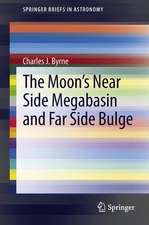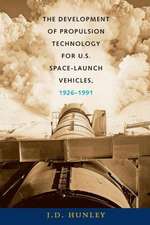Geochemical Exploration of the Moon and Planets: Physics and Chemistry in Space, cartea 3
Autor I. Adler, J. I. Trombkaen Limba Engleză Paperback – 18 apr 2012
Din seria Physics and Chemistry in Space
-
 Preț: 385.84 lei
Preț: 385.84 lei -
 Preț: 382.18 lei
Preț: 382.18 lei - 15%
 Preț: 643.84 lei
Preț: 643.84 lei -
 Preț: 383.50 lei
Preț: 383.50 lei - 18%
 Preț: 729.84 lei
Preț: 729.84 lei - 15%
 Preț: 642.83 lei
Preț: 642.83 lei - 15%
 Preț: 637.59 lei
Preț: 637.59 lei -
 Preț: 385.08 lei
Preț: 385.08 lei -
 Preț: 381.98 lei
Preț: 381.98 lei -
 Preț: 381.43 lei
Preț: 381.43 lei - 15%
 Preț: 637.78 lei
Preț: 637.78 lei - 15%
 Preț: 634.49 lei
Preț: 634.49 lei -
 Preț: 388.34 lei
Preț: 388.34 lei -
 Preț: 392.21 lei
Preț: 392.21 lei - 15%
 Preț: 697.47 lei
Preț: 697.47 lei -
 Preț: 382.18 lei
Preț: 382.18 lei - 15%
 Preț: 643.84 lei
Preț: 643.84 lei -
 Preț: 383.50 lei
Preț: 383.50 lei -
 Preț: 385.08 lei
Preț: 385.08 lei -
 Preț: 385.08 lei
Preț: 385.08 lei - 18%
 Preț: 778.32 lei
Preț: 778.32 lei - 18%
 Preț: 777.83 lei
Preț: 777.83 lei -
 Preț: 381.81 lei
Preț: 381.81 lei
Preț: 638.43 lei
Preț vechi: 751.10 lei
-15% Nou
Puncte Express: 958
Preț estimativ în valută:
122.17€ • 127.87$ • 101.68£
122.17€ • 127.87$ • 101.68£
Carte tipărită la comandă
Livrare economică 31 martie-14 aprilie
Preluare comenzi: 021 569.72.76
Specificații
ISBN-13: 9783642492808
ISBN-10: 3642492800
Pagini: 256
Ilustrații: X, 244 p.
Dimensiuni: 155 x 235 x 13 mm
Greutate: 0.36 kg
Ediția:Softcover reprint of the original 1st ed. 1970
Editura: Springer Berlin, Heidelberg
Colecția Springer
Seria Physics and Chemistry in Space
Locul publicării:Berlin, Heidelberg, Germany
ISBN-10: 3642492800
Pagini: 256
Ilustrații: X, 244 p.
Dimensiuni: 155 x 235 x 13 mm
Greutate: 0.36 kg
Ediția:Softcover reprint of the original 1st ed. 1970
Editura: Springer Berlin, Heidelberg
Colecția Springer
Seria Physics and Chemistry in Space
Locul publicării:Berlin, Heidelberg, Germany
Public țintă
ResearchCuprins
1: Introduction.- Mars.- The Moon.- Venus.- The Outer Planets.- Achievements in Planetology.- Progress in Lunar Studies Since 1958.- Summary.- References.- 2: Instruments Used for Compositional Exploration.- Scientific Objectives.- Chemical Analysis by Alpha Particle Back Scattering and Proton Spectroscopy.- Principles.- Proton Spectra from (?, p) Reactions.- Data Interpretation.- Instrumentation.- Mission Description and Results (Surveyor V).- Surveyor VI.- Results and Discussion of the Surveyor VI Alpha-scatter Experiment.- Surveyor VII (see Franzgrote et al., 1968).- Results and Discussion.- Lunar Surface Magnet Experiment.- Magnet Assembly.- Laboratory Studies.- Surveyor V Mission.- Discussion of the Surveyor V Results.- Surveyor VI Magnet Experiment (see Negus de Wys, 1968).- Surveyor VII (see Negus de Wys, 1968).- Observations.- Conclusions.- Density Measurements of the Lunar Surface by Gamma Ray Scattering.- Data Interpretation.- Results.- Gamma Ray Spectroscopy from Lunar Orbit.- Instrumentation.- Ranger 3 Results.- Luna 10 Results.- References.- 3: Instruments and Techniques Under Development.- X-Ray Spectroscopy.- JPL. Lunar X-Ray Spectrograph (see Metzger, 1964).- Specimen Requirements.- Sample Conductivity.- Sample Heating.- Compactness and Surface Smoothness.- Rock Analysis.- Goddard Space Flight Center-Panametrics Spectrometer.- Principles.- Instrumentation.- Data Analysis.- X-Ray Diffraction Techniques for Lunar and Planetary Studies.- Principles.- Sampling and Sample Preparation.- Data Handling and Interpretation.- Orbital X-Ray Fluorescence Experiment (Adler et al., 1969).- Experimental Approach.- Instrument Description.- Orbital Analysis of Surface Composition by Gamma Ray Spectroscopy.- Experiment Approach.- Equipment Description.- Future Direction.-Orbital Analysis of Soil Composition by Infrared Techniques.- Principles.- Goddard Space Flight Center Four Channel Radiometer (Hovis and Lowman, 1968).- Orbital Analysis of the Lunar Surface by Alpha Particle Spectroscopy.- Scientific Description.- Instrument Description.- Neutron Methods.- Experiment Configuration and Operation.- Mass Spectroscopy for Lunar and Planetary Exploration.- Mass Spectrometer for Atmospheric Gases (Spencer and Reber, 1962).- Results.- Lunar Atmosphere Mass Spectrometer (Hoffman, 1969).- Instrumentation.- Mass Spectrometer for the Analysis of Solids (Hertzog, 1965, Kreisman, 1969).- Results.- Gas Chromatography.- Combined Gas Chromatography—Mass Spectrometry.- References.- 4: Apollo Surface Missions and the Lunar Receiving Laboratory Program.- Landing Sites.- Apollo Mission Profiles.- Contamination Control.- Lunar Receiving Laboratory (LRL).- Sample Flow Through the Lunar Receiving Laboratory (LRL).- Detailed Studies of Lunar Samples.- Results of the Preliminary Examination of the Apollo 11 Lunar Samples.- Geologic Description.- Description of the Rocks.- Mineralogy and Petrology.- Chemical Analysis.- Rare Gas Analysis.- Preliminary Age Determinations.- Gamma-Ray Measurements.- Organic Analysis.- Conclusions.- References.- 5: Date Processing and Analysis.- Pulse Height and Digital Spectra.- Measurement of Pulse Height Spectra.- Formulation of the Least-Square Analysis Method.- Calculation of Errors.- Method of Solution Using Non-Negativity Constraint.- Compensation for Gain-Shift and Zero-Drift.- Preparation of the Library.- Correlation and Resolution.- Background Compensation.- Application of Least-Square Techniques to Experimental Problems.- On-Line Data Analysis.- Summary.- References.- 6: Orbital and Surface Exploration Systems AfterEarly Apollo.- General Considerations for Geochemical Exploration Missions.- Orbital Missions.- Critical Parameters for Lunar and Martian Investigations.- Background Measurements.- Methods for Dealing with Background Radiation.- Expected Results from an Integrated Experiment.- Interdependence of Measurements.- Orbital Missions.- Surface Missions.- Surface Rovers.- Soft and Hard Landing Probes.- Planetary Exploration.- References.
















